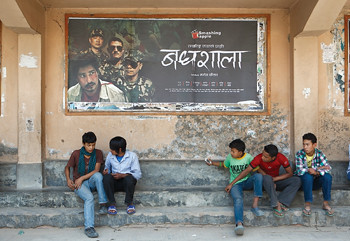With the peace process officially over, Nepal’s security forces need to downsize and rethink their roles

BIKRAM RAI
For the past month and a half, the reels of Manoj Pandit’s controversial new movie, Badhshala, have shuttled back and forth between the Nepal Army, the Ministry of Defence, and the Censor Board.
The film depicts graphic scenes from the army’s torture chambers during the war at the Bhairabnath Battalion. The NA initially said it objected because the actors wore military uniforms without permission. A few weeks later, it changed its tune and said the movie shouldn’t be released as it could ‘derail the peace process’, a euphemism that in recent years is used regularly by both state security and the Maoists to hide wartime atrocities they committed. The film was finally allowed to screen in theatres after the producers agreed to cut a few ‘problematic’ torture scenes.
Badhshala is a flawed historical drama because it only depicts one side of the conflict and there is no doubt that the Maoist party would have reacted in exactly the same way if the story was about torture and summary executions by the Maoists.
However, as a filmmaker in a democratic country with constitutionally guaranteed provisions on the freedom of expression, Pandit and his team have the artistic right to pick and choose sides to represent history in ways they see fit.
By trying to ban Badhshala, the army and Defence Ministry overstepped their jurisdiction and also exposed their deep sense of insecurity which they need to address not by looking for outside targets but through self-examination. With the peace process now officially over, some introspection is in order for Nepal’s security forces to rethink their priorities and redefine their roles in a post-conflict society.
A country of 26 million currently supports an army 96,000 strong. There are another 35,000 men under arms in the APF, the paramilitary force set up to fight the Maoists and never disbanded. The state spends about Rs 24 billion just on the NA, up from Rs 18 billion in 2010/11. The army’s budget is rising even though the war has been over for seven years and will go up further after the cabinet lifted restrictions imposed by the Comprehensive Peace Agreement on weapons purchases last week.
In a country where half the children go to bed hungry every night, it is a travesty to waste so much on the military. For this to happen the state has to limit the army’s role and downsize it to pre-war levels. A 50,000 strong NA looking after disaster management, infrastructure security, and wildlife is more than enough for Nepal. We need to redefine security in terms of well-being of Nepalis and not on the strength of our military. For lasting peace, we need more schools, more trained teachers, and healthcare workers, not more helicopters and guns.
With the police to oversee day-to-day law enforcement and the army for state security, there is a case for completely disbanding the APF. However, since the security forces are one of the biggest employers in Nepal, the state will have to implement the long-overdue Security Sector Reform plan.?
Since restructuring the country’s defence system requires time and a more stable polity, the security forces in the meantime should try to rebuild the trust that was lost during the conflict. The army for its part has to allow an independent Truth and Reconciliation Commission, whenever it is formed, to conduct investigations without interference. Otherwise it will squander even the remaining goodwill it has among Nepalis. Making entry into the forces more accessible for women and other marginalised communities and easing the rigid hierarchy within will also help in an image makeover.
The police, on the other hand, have to treat ordinary Nepalis with respect and show greater accountability. It does not send a good message when riot police in full gear watch on as party-backed hooligans set vehicles ablaze and at another end of town arrest peaceful protesters.
While chiefs of the past are known by the wars they won, the chiefs of today will be remembered by how popular and respected their men and women are among ordinary Nepalis.?
Read also:
The disappearance of truth
Badhshala directed by Manoj Pandit